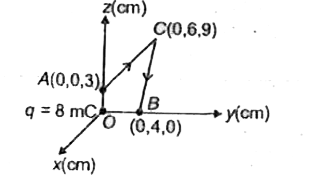
Q. How much work is done by the electric field created by the stationary charge +Q=+2.0C to move a charge of +1.0×10−9C from position X to position Z? (Note: The value of coulomb's constant, k, is 9×109N⋅m2/C2)
0J
150J
300J
560J
The correct Answer is:A
The change in the electrical potential energy as a charge q moves from position X to position Z is equal to q times the difference in potential between the points: ΔPE=qV=qΔΦ=q(ΦZ−ΦX). Because position X and Z are equidistant from the source charge (+Q), the potentials at these locations are the same. since ΔΦ=0, there is not change in potential energy, so the work done by the electric field is also zero.
Topper's Solved these Questions
Similar Questions
A charge of 8 mC is located at the origin. Calculate the work done in taking a small charge of −2×10−9C from a point P(0,0,3 cm) to a point Q10,4 cm, 0) via a point R(0,6 cm, 9 cm).
View SolutionA charge of 8 mC is located at the origin. Calculate the work done in taking a small charge of −2×10−9C from a point P (0,0,3 cm) to a point Q (0,4 cm, 0) via a point R (0,6 cm, 9cm).
View Solution
Knowledge Check
Calculate the work done in taking a charge −2×10−9C from A to B via C (in diagram )
 A0.2 jouleB1.2 jouleC2.2 jouleDzero
A0.2 jouleB1.2 jouleC2.2 jouleDzeroA hollow sphere of radius 0.1 m has a charge of 5×10−8C. The potential at a distance of 5 cm from the centre of the sphere is
(14πε0=9×109Nm2C−2)A4000 VB4500 VC5000 VD6000 VThe electric field due to a charge at a distance of 3 m from it is 500NC−1. The magnitude of the charge is
[14πε0=9×109N−m2/C2]A2.5μCB2.0μCC1.0μCD0.5μC
A hollow sphere of radius 0.1 m has a charge of 5×10−8C. The potential at a distance of 5 cm from the centre of the sphere is
(14πε0=9×109Nm2C−2)
View SolutionThe electric field due to a charge at a distance of 3 m from it is 500NC−1. The magnitude of the charge is
[14πε0=9×109N−m2/C2]
View SolutionIn the rectangle, shown below, the twp corners have charges q1=−5μCandq2=+2.0μC. The work done in moving a charge +3.0μC from B to A is (take 1/4πε0=1010N-m2/C2)

View SolutionA spherical conductor of radius 10 cm has a charge of 3.2 x 10^-7 C distributed uniformly. What is magnitude of electric field at point 15 cm from centre of sphere?
View SolutionIn the rectangle, shown below, the twp corners have charges q1=−5μCandq2=+2.0μC. The work done in moving a charge +3.0μC from B to A is (take 1/4πε0=1010N-m2/C2)

View Solution
